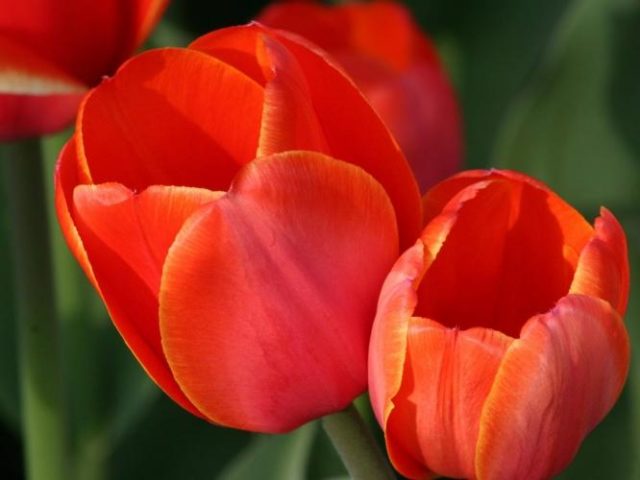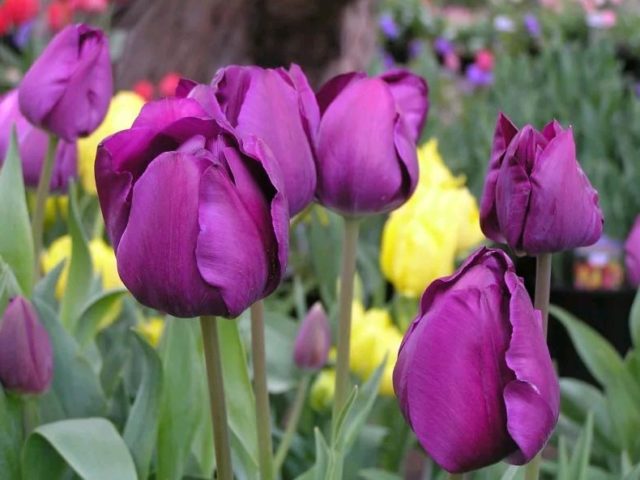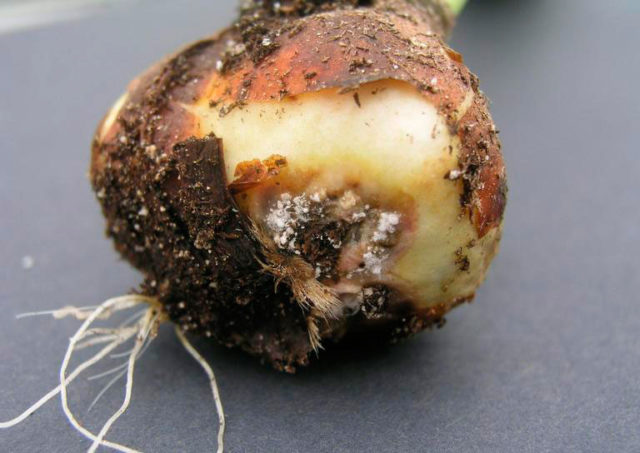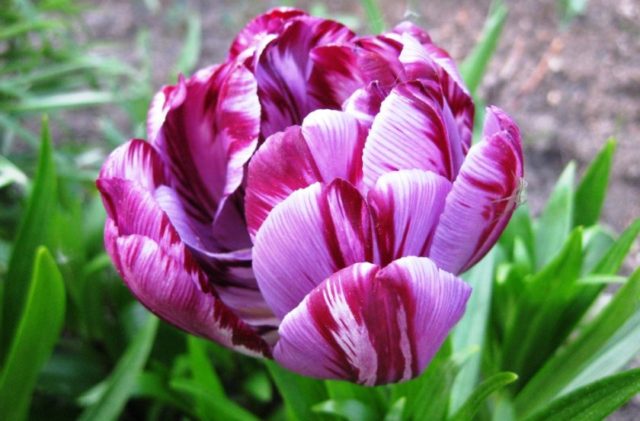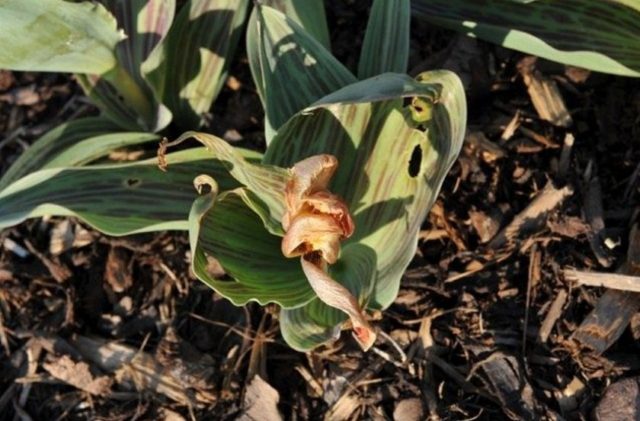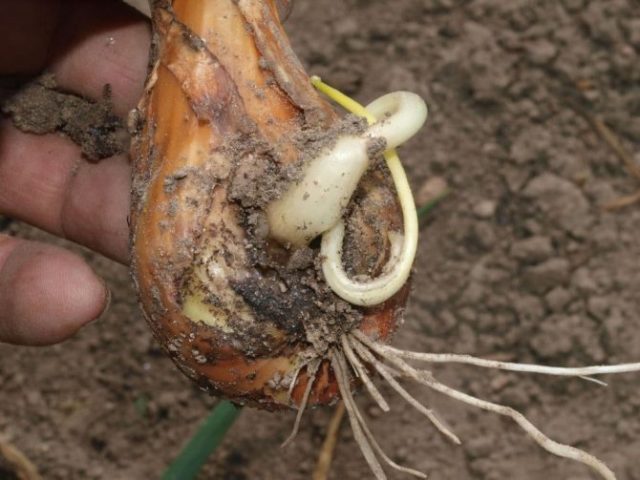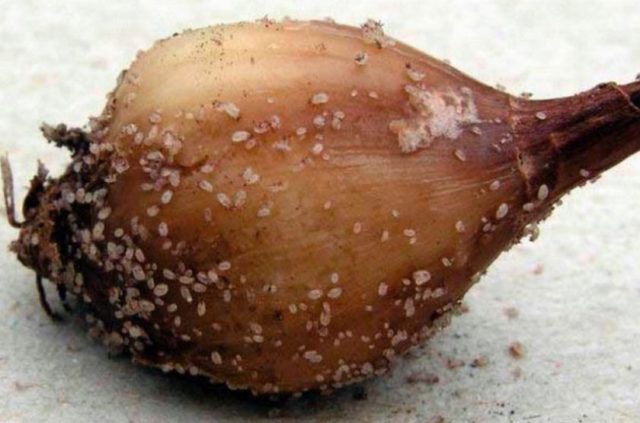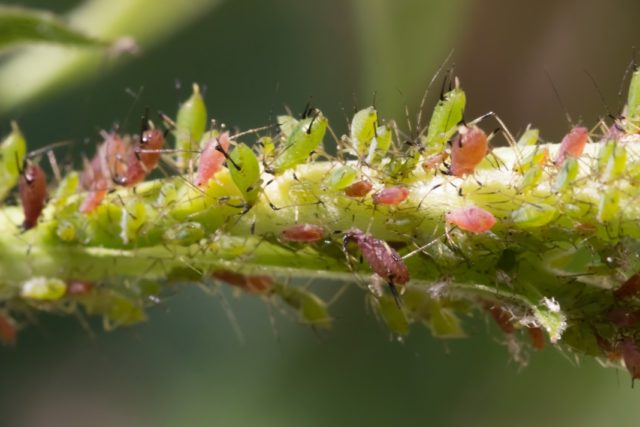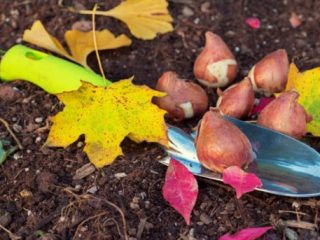Content
- 1 Is it possible to plant tulips in pots
- 2 Suitable varieties
- 3 Features of growing tulips in pots
- 4 How to plant tulips in a pot at home
- 5 How to grow tulips in a pot at home
- 6 Forcing tulips in pots
- 7 How to grow potted tulips outdoors
- 8 Care rules during the flowering period
- 9 What to do after flowering
- 10 Diseases and pests
- 11 Reasons for possible failures
- 12 Conclusion
Potted tulips at home are gaining popularity; a garden bed for their cultivation is not at all necessary. But to achieve beautiful flowering in a small container is possible only if the rules are followed.
Is it possible to plant tulips in pots
Perennial tulips are often perceived as exclusively garden plants, unsuitable for home cultivation. This is not true - you can drive out flowers in pots. This method has its advantages, the soil is consumed less, it is easier to control the level of humidity and temperature.
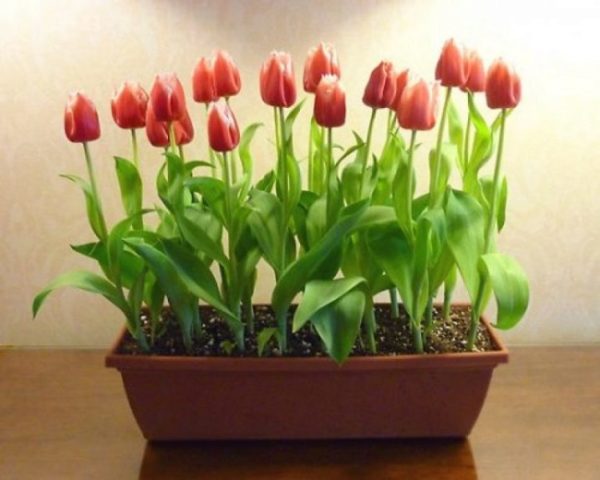
You can sprout tulips in a pot at home even in winter.
At the same time, home cultivation has its own difficulties. Tulips require conditions that are as close to natural as possible, otherwise they will not be able to please with flowering.
Suitable varieties
It is possible to grow tulips at home in a pot from low-growing varieties, they have greater endurance and resistance to diseases. Among the most popular varieties are:
- Oxford (Oxford);
Oxford tulip grows up to 50 cm
- Negrita Double;
The height of the Negrita Double variety is about 40 cm
- Christmas Marvel (Christmas Marvel);
Marvel Christmas variety grows up to 25-40 cm
These varieties germinate quickly and easily, so even a novice florist can handle forcing.
Features of growing tulips in pots
Tulips germinate well in small pots, but there are some important things to keep in mind when forcing:
- Conditions should be as close to natural as possible. Flowers require a stable temperature regime, moderate moisture and diffused lighting.
- The air in the room where perennials grow should be humid. It is better to keep the pots away from the central heating batteries; if possible, it is necessary, in principle, to lower the temperature of the radiators.
- You can plant a tulip bulb at home in a pot after stratification. Cold storage is a fundamentally important stage, since it is during this period that the planting material accumulates nutrients.
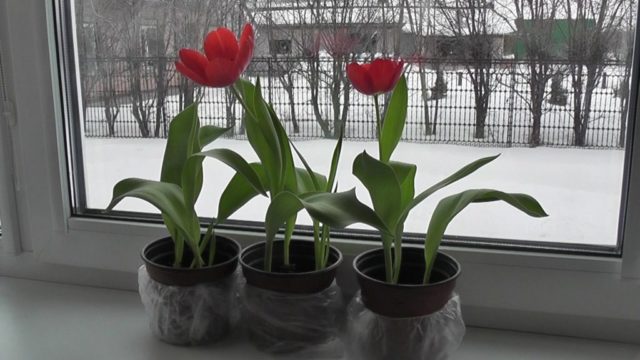
Potted tulips can be placed on the windowsill in the absence of a draft
The best places for distillation in an apartment are a windowsill or a glazed balcony. In these places, perennials will be able to receive enough light. But it is important to consider that spring flowers do not like drafts, and they need a very moderate temperature. It is impossible to put the pots on the window or on the balcony if it draws cold air from the frame, you should not place them close to the radiators.
How to plant tulips in a pot at home
To successfully plant tulips in pots, you need to pay attention to each of the stages. Subject to the rules, the idea will be quite simple.
Recommended timing
Tulips are planted both in the ground and in pots at the same period. They begin to plant the bulbs in September and finish in December. Specific dates depend on when exactly you want to see flowering.
Dates of planting tulips in pots in autumn and winter
Autumn remains the optimal time for planting. If you have to root the bulbs, independently dug out of the flower bed on the site, then they should be laid for cooling in September. Purchased planting material can be placed in the ground later, with the onset of cold weather, in October or even November.
As for the winter planting, it is rarely practiced and is carried out no later than the beginning of December. If you skip the dates, then tulips will bloom too late, and they are grown in pots, including for getting early buds.
Planting time depending on flowering period
If you wish, you can grow tulips in a pot at home in winter for a specific holiday. Landing times are calculated as follows:
- before forcing, the bulbs must be kept in a cold, dark place for 16-18 weeks;
- after cooling, tulips can be transferred to heat and light, but their development will take another 3-4 weeks.
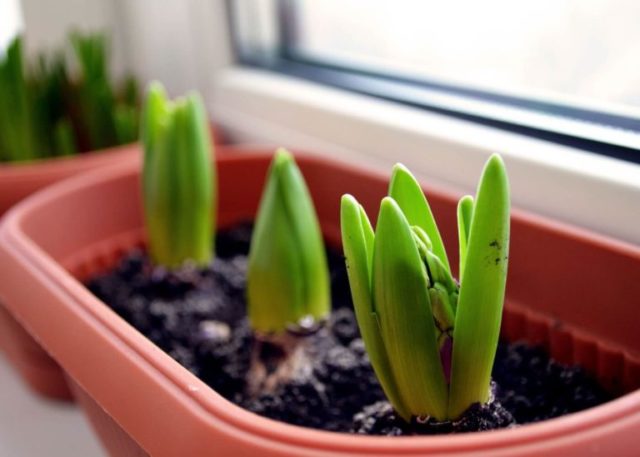
Since it takes approximately 20 weeks to grow tulips indoors, flowering can be organized by the desired date.
Thus, from the desired date, you need to count about 20 weeks and find out the landing date. For example, to get flowers by February 23, the bulbs will need to be planted around October 6, and for distillation by February 14, no later than September 27.
When to plant tulips in a pot by March 8
Traditionally, it is recommended to plant the bulbs in the ground by March 8 no later than October 1. In this case, in early February, the seedlings can be removed from the refrigerator. After that, you need to carry out the usual distillation and get the buds for the women's holiday.
Selection of containers and soil preparation
The container for germination should be deep enough, at least 15 cm, and preferably 20-40 cm. It is recommended to take wide pots about 20 cm in diameter and plant several bulbs in them at once. There must be drainage holes at the bottom, otherwise moisture will stagnate.
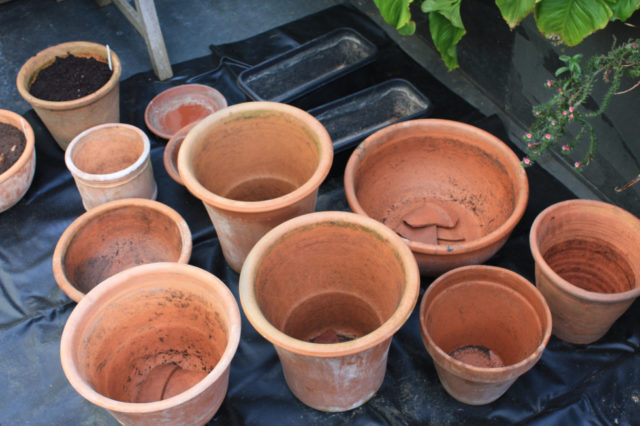
For growing tulips, it is best to take clay pots, in them you can create the most natural conditions
As soil for tulips in a pot, take peat mixed with sand, or garden soil with the addition of an equal amount of compost. Before planting, the soil is recommended to be calcined in the oven or treated with a solution of potassium permanganate, this will eliminate dangerous microorganisms.
Preparing the bulbs
Like the soil, the bulbs must be disinfected before planting. To do this, they are placed in cool water for half an hour with the addition of potassium permanganate. It is also recommended to remove the brown upper scales from the tubers, in which case they will germinate faster. Only the healthiest material should be taken for planting in pots.
How to plant tulips in a pot at home
The planting material is buried about 3 cm, while the top of the bulb should be slightly visible above the soil.
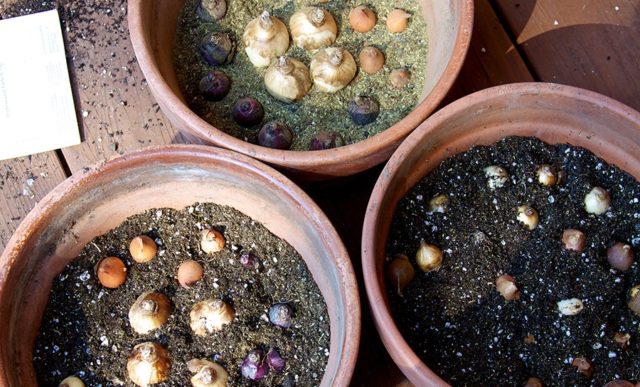
At home, several bulbs are planted in a pot at once - flowering in this case will be more abundant
Immediately after planting, the soil in the pot is watered, calcium nitrate can be added to the water - 10 g per 5 liters. If the soil settles slightly, it will need to be filled up so that only the tops of the bulbs still protrude above the surface.
How to grow tulips in a pot at home
An important step in growing indoor tulips in a pot is stratification in the cold. Immediately after planting, the container is moved to the refrigerator or to the basement - the temperature should be from 5 to 10 ° C. In such conditions, the seedlings are kept for 16-18 weeks, periodically moistening the soil.
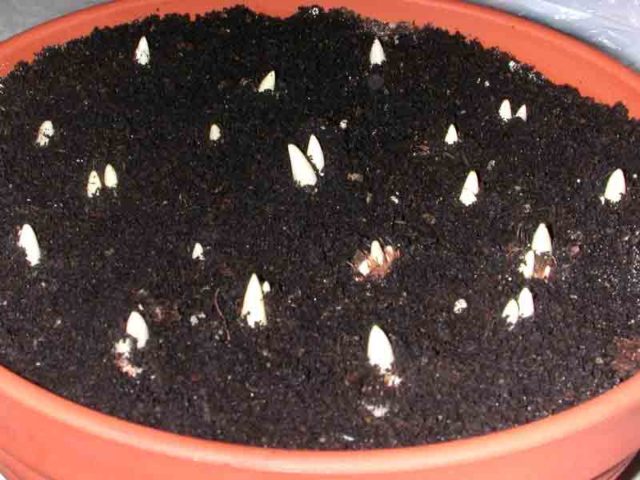
Tulips begin to sprout already during stratification.
Forcing tulips in pots
After cooling for a long time, the pots can be moved to a lighted place with a temperature of about 12 ° C. There should be no drafts on the selected windowsill or on the glassed-in balcony, and seedlings should not be placed next to radiators. Light is required diffused, without direct sunlight, the duration of daylight hours should be at least 10 hours.
Throughout the forcing, tulips in a pot on the windowsill continue to be watered twice a week and sprayed with a spray bottle. You can make top dressing 1-2 times a month - potassium sulfate and calcium nitrate.
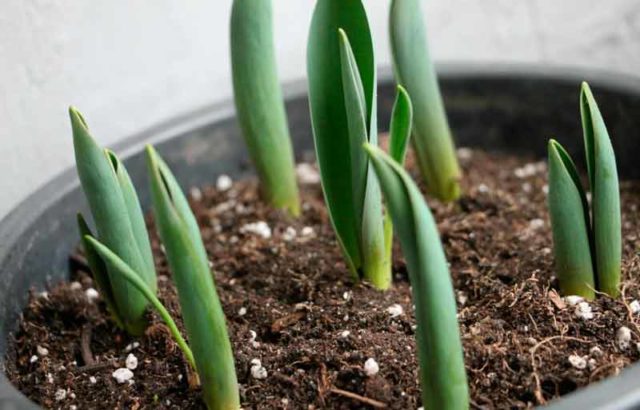
The process of forcing indoor tulips takes about 3 weeks.
If a few days before the required date, the tulips have already released their buds, but have not yet blossomed, they can be artificially rushed. To do this, the temperature in the room is added to 18-20 ° C and the daylight hours are increased for a couple of hours using a lamp.
How to grow potted tulips outdoors
In winter, cultivation is carried out at home - in the fresh air, the flowers will die. But with the onset of spring, many gardeners choose to plant bulbs in outdoor pots.
Recommended timing
As with indoor cultivation, it is recommended to plant tulips in outdoor pots in the fall, from late September to mid-November. The bulbs are placed in containers, and then simply left outside until spring. If the winters are very harsh, you can bring the pots to the basement or refrigerate during the frost.
Planting tulips in pots in spring is also not prohibited; it can be carried out in March or April. But if you do this without prior stratification, then, most likely, there will be no flowering in the current season. Therefore, it is still advisable to lay the bulbs in a flowerpot in January-February and keep them in the cold, and with the onset of spring, take them out into the fresh air.
Preparation of containers and soil
Pots and soil for tulips on the street are selected according to the same rules as for home planting. It is recommended to take ceramic containers, sufficiently deep and wide, not less than 20 by 20 cm. In them, even several perennials will feel quite free. At the bottom of the pots, holes are made to drain moisture and a drainage layer is poured - charcoal, gravel or expanded clay.
The soil mixture can be bought in a specialized store, or you can make it yourself by mixing 1 part of sand and humus with 2 parts of sod land. The pH level for tulips is suitable for neutral or slightly alkaline, flowers do not like acidic and strongly alkaline soils. Immediately before planting, the soil is treated with calcination or a disinfecting solution to eliminate possible microorganisms.
How to plant tulips in a pot outdoors
The tulip pot is filled with prepared soil so that about 12 cm remains to the edges. After that, the planting material is placed with a distance of 5 cm between the individual bulbs. Perennials are sprinkled on top with the remains of soil until about 3 cm remains to the sides, and they are carefully watered, trying not to erode the soil.
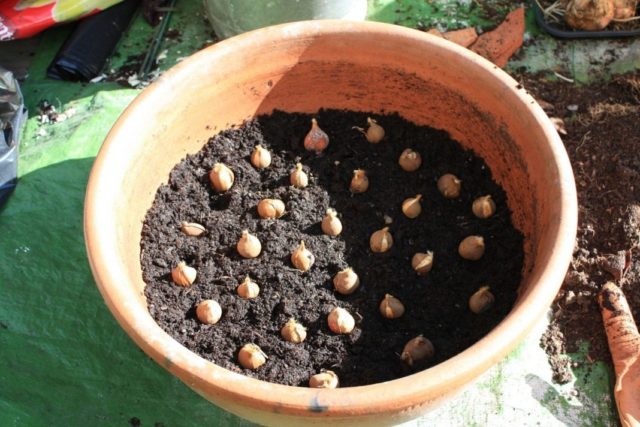
When planting tulips in the autumn, they are laid in pots quite deep so that the bulbs do not freeze over the winter.
If planting is carried out in the fall, the pots can either be left outside or brought into a cold basement or garage. When planting in spring, flowerpots are left in the open air.
Caring for tulips in pots on the site
It is quite simple to care for perennials sprouting in pots:
- Tulip bulbs require regular watering. It is carried out as the earth dries up in the flowerpot, usually no more than twice a week. Water is poured exclusively at the root, without affecting the stem and young leaves.
- Before flowering, perennials are fed with nitrogen and potassium fertilizers, on average, twice, with an interval of 2 weeks. Potassium sulfate and calcium nitrate are well suited for the culture, the minerals strengthen the endurance of tulips and accelerate growth.
- If the temperature on the site is unstable, then in the evenings the pot can be covered with burlap or other non-woven material. Sudden transitions from daytime heat to nighttime cold can injure the bulbs.
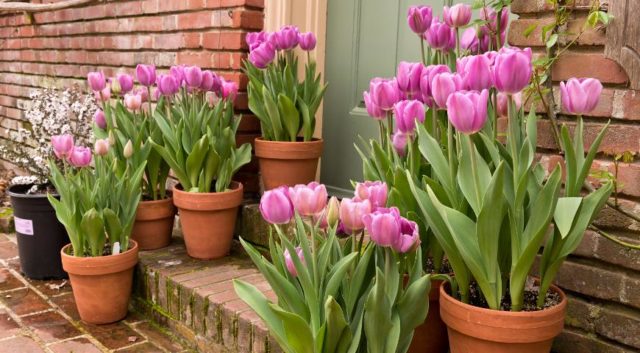
Keep tulips on the site in a lighted place, but not in direct sunlight
Care rules during the flowering period
In order for the flowering to be bright, abundant and long-lasting, you must adhere to simple rules. Namely:
- continue to regularly moisten the soil in pots, the buds consume a lot of nutrients;
- keep flowerpots away from direct sunlight and high temperatures, tulips do not like heat and bloom very quickly with excess heat;
- regularly spray the plantings - this is especially important for indoor perennials suffering from dry air.

For tulips to bloom longer, they need to be sprayed and shaded from the direct sun.
Perennials grow outdoors with a natural slight drop in nighttime temperatures. Homemade tulips in pots can be rearranged every night to a slightly cooler place to simulate natural conditions. Flowering in this case will last a little longer.
What to do after flowering
At the end of flowering, the tulips in the pots must be cut off. Only the peduncles are removed, and the stems with leaves are left and continue to water until they wilt naturally. Immediately after this, the bulbs must be removed from the pot, peeled and dried. Then the planting material is harvested in a cool place with low humidity.
In autumn, the dried bulbs can be planted outdoors. They are not suitable for re-forcing in pots, since they will take 1-2 years to recover.
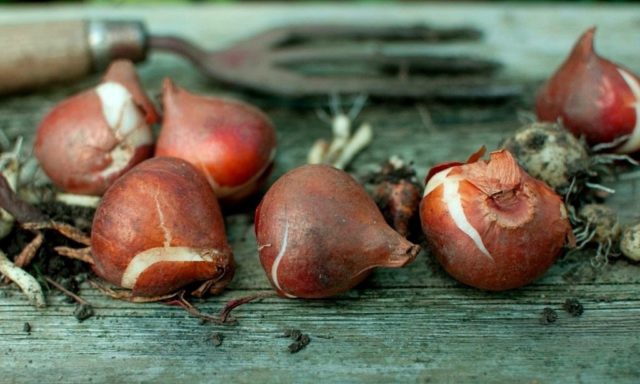
After flowering, the tulip bulbs are removed from the pot for drying and storage.
Diseases and pests
Tulips are a fairly sensitive crop to fungi and pests. The main danger for flowers is:
- fusarium;
With fusarium, tulip tubers begin to rot
- typhulosis;
Typhulosis of tulips leads to rotting of the roots, and then of the bulbs
- variegated virus;
The variegation virus gives the buds an unnatural color
- August disease;
With August disease, tulip leaves become covered with brown strokes and wither
Ailments develop most often in conditions of waterlogging and high temperature. If the plant is sick, then it is almost impossible to save it, usually the infected bulbs are simply dug up and destroyed. The fight against viruses and fungi is carried out prophylactically - before planting, the soil and plant material are treated with potassium permanganate or fungicides.
Of the pests for the plant are dangerous:
- root nematodes;
Nematodes lead to the formation of growths on the tulip bulb and prevent the plant from developing
- root onion mite;
A root onion mite can enter a pot outdoors and damage tulip tubers.
- aphid;
Aphids are especially harmful to tulips in outdoor pots.
At the first sign of pest infestation, tulips can be treated with Karbofos. If there is no result, the bulbs must also be dug up and destroyed.
Reasons for possible failures
It is not always possible to grow tulips in a pot or flowerpot the first time. The most common mistakes include:
- planting without stratification, if the bulb was not previously kept in the cold, then the tulip will germinate, but it will not bloom;
- waterlogging - the closed soil is especially often swamped, and the roots of the plant begin to rot;
- poor-quality planting material, small bulbs dug out of the flower bed too early do not germinate well in pots, since they do not have a sufficient supply of nutrients.
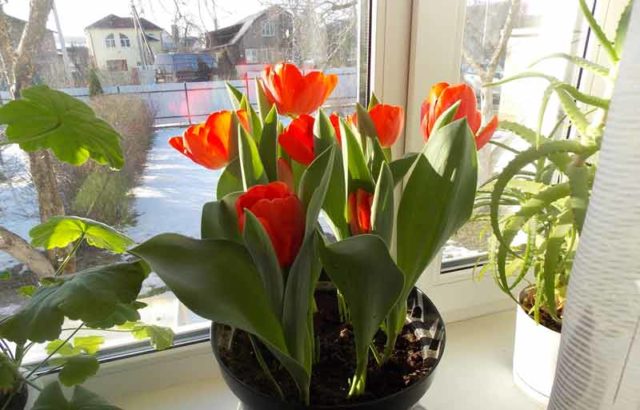
For successful germination in a pot, a tulip needs light and moderate watering.
Lack of daylight often leads to failure. If you grow perennials at home in a shaded corner of the apartment, then they will not bring buds, or they will be very small, weak and will not open.
Conclusion
Potted tulips at home can be grown much ahead of schedule - in March or even February. The rules are quite simple, but you need to pay attention to the pre-cooling of the bulbs, flowering depends on it.
